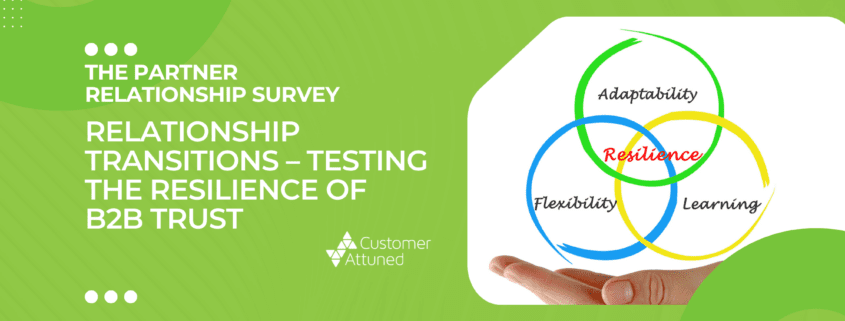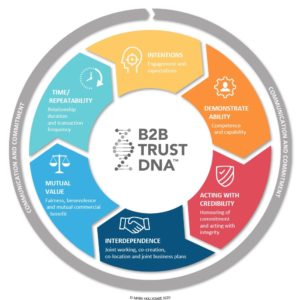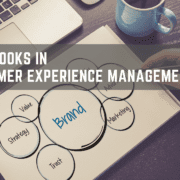Relationship Transitions – Testing the Resilience of B2B Trust
Relationship Transitions – Testing the Resilience of B2B Trust
In my last blog about contract activation, I considered how important the activation / onboarding phase is to the establishment of long-term, mutually valuable and trust-based business relationships.
In our experience helping B2B companies around the world building mutually valuable, trust-based relationships, we have pinpointed some distinct occurrences that stress test the quality of the relationship. We have grouped these into what we call “transitions”.
Change is uncomfortable
It is well known and much researched that people don’t like change. This is just as true across the boundaries of a B2B customer/supplier relationship as it is within a company.
But change is inevitable. People move on. Disruption happens. Contracts come to an end.
A good contract should be able to flex according to market conditions within its boundaries, but there are vital elements of relationship management that require careful attention beyond the protection of SLA or KPI performance.
So, what do we mean by “transitions”?
There’s no text book definition, but we are talking about occurrences and changes that happen over several months, rather than events or catastrophic incidents that require emergency action or intensive relationship recovery (which I cover in my next blog). Here are five examples of such transitions:
- When the key responsible point-person on either side of the relationship leaves (and more so if there’s change on both sides at the same time)
- When structural or organisational changes occur. This could be because of consolidation, merger or acquisition on either side of the relationship that change the landscape of the contract
- When external factors require a material contract re-negotiation. We’re talking big international events here – pandemics, wars, national sanctions, trade embargos, etc.
- In the run-up to contract re-tender where the supplier is in the running for contract renewal or extension
- When the contract is ending and a new supplier is taking over
How resilient is the trust within your key B2B relationships?
In considering these periods of transition, my colleague Dr Mark Hollyoake’s ground breaking work on B2B Trust is extremely useful.
His Trust DNATM model starts with Intentions – joint clarity and agreement about what the business relationship is setting out to achieve – but it soon gets into the reality of working together through thick and thin to deliver on those good intentions.
In particular, the elements of his model that cover acting with Credibility, Interdependence and Communication will be stress tested in periods of transition. Mark’s research has uncovered numerous critical incidents, attitudes and behaviours that will either enhance or destroy trust in these situations.
If the trust-building principles are adhered to, then optimal Mutual Value and Commitment will be assured.
Managing transitions
Here are some approaches that will make a real difference to long-term success in the five examples given above:
- Key people handover. This one may sound trivial compared to the others, but perhaps that’s the reason why it gets tripped over so often. Even when people leave for wholly positive reasons such as promotion, we must not assume that the transition will be seamless and painless for their successor. The secret here is leadership on both sides recognising the potential for relationship vulnerability during the transition and then providing positive and intentional reinforcement for as long as it takes – not just introducing the new account director/manager and letting them get on with it!
- Structural change. This happens surprisingly often e.g. when two suppliers to the same company merge and the customer ends up with two account managers/teams from the same company! Alternatively, this could be for a good reason e.g. the supplier wins business with a different division or subsidiary of the same company – effectively making themselves a key supplier or ‘partner’. How this is managed will be a real test of how customer centric the organisation really is. If either side is heavily siloed, has internal P&Ls, or has empire-building leaders then the customer experience is going to suffer. Getting this right is all about people being willing to collaborate and act in the interests of the total relationship rather than their particular piece of it
- External Factors. These are problems not of either company’s making and are not going to be resolved overnight. You will find out here if the contract is the servant of the relationship, or if it’s the other way round. The key thing to have is a grown-up conversation about if and how spirit of the relationship’s Intentions can still be achieved despite the changed circumstances. This can then lead to trust-based negotiations for an outcome that salvages some mutual value for both sides
- Retender. This is a transition that does tend to be better managed in B2B but even then, there’s a risk that BAU delivery and the change schedule can take a back seat while everyone’s focused on the bid to renew the contract. Good change programme management really helps here, with a log of the projects that will span contract-end with contingency plans for every potential outcome. This confirms the Ability and Commitment elements of the trust model
- Exit. This is a moment of truth for the reputation of both companies. There’s a real temptation on the supplier’s side to shift their best people onto more enduring contracts, resulting in the loss of vital knowledge and experience over and above the written processes and procedures. The best companies do everything possible to “leave a contract well”
Customer Attuned can help
Everyone agrees that trust is vital to good B2B relationships, but most don’t have a way to assess how it is being built, retained or lost through transitions. This is where our Partner Relationship Survey can help – a proven and cost-effective approach that tracks each element of trust over time.
Do you want to get better at managing such transitions? Are you looking for a way to pragmatically embed and assess trust over time? You may wish to take part in Dr Mark Hollyoake’s next phase of academic research into the key roles that span the boundaries of B2B relationships?
If so, then please get in touch. We would love to discuss your challenges and opportunities to better manage relationship resilience throughout the whole B2B contract cycle.
Listen to what our clients say about the survey here
Read more about the Partner Relationship Survey here.
- Customer Strategy in the B2B Membership Sector - May 27, 2025
- Build a B2B Customer Strategy - May 20, 2025
- Should you implement NPS in B2B? - January 22, 2025







